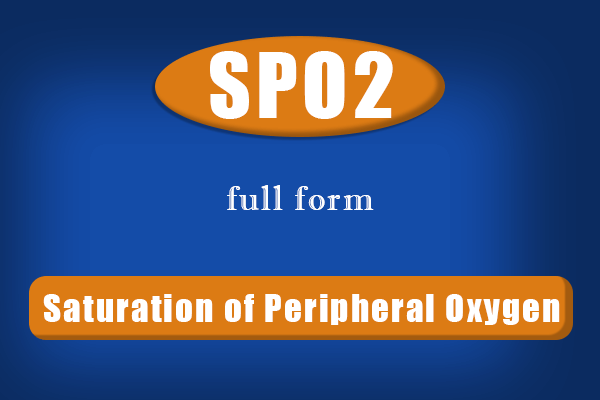What is the Full Form of SpO2SpO2: Saturation of Peripheral OxygenSpO2 stands for Saturation of Peripheral Oxygen. SpO2 can be divided into the following parts where "S" stands for saturation, "P" for a pulse (the "SP" can also stand for serum pressure), and "O2" stands for oxygen. SpO2 is also sometimes referred to as oxygen saturation. The acronym represents a measurement of oxygen that hemoglobin cells in the circulatory system have attached to them. This measurement essentially shows how much oxygen has been transported by red blood cells. Simply put, SpO2 is a measurement that shows how well a person is breathing and distributing blood throughout the body. SPO2 represents this value as a percentage. A healthy, average adult's SpO2 reading is usually between 96% and 99%. 
Measuring SpO2A pulse oximeter, which comprises a computerized monitor and probe, is used to measure SpO2. Since long ago, these pulse oximeters have been in use. The patient's finger, toe, nostril, or earlobe may be attached to the probe. The amount of oxygen in the patient's blood is then indicated by a measurement on the monitor. It accomplishes this by using an audio signal that correlates to the patient's pulse and a waveform that may not be visually viewed. As the blood saturation drops, so does the signal's tone. Based on the oximeter quality, the monitor may additionally display heart rate and sound an alarm for extremely high/low saturation levels to notify the user. Woking ConceptMany individuals are interested to know how they (oximeters) work as they are comparatively popular in homes these days. In order to track how much blood is transporting oxygen and how much is not, pulse oximeters use light sensors. Because oxygen-saturated hemoglobin appears to the naked eye to be a brighter red than non-oxygen-saturated hemoglobin, this phenomenon enables the pulse oximeter's extremely sensitive sensors to detect and translate minute fluctuations in the blood into a measurement. Both deoxygenated and oxygenated types of blood are measured by the SpO2 instrument, i.e., an oximeter. These two separate types of blood are measured using two different frequencies: red and infrared. It is known as spectrophotometry, where Desaturated hemoglobin is measured using the red frequency, while oxygenated blood is measured using the infrared frequency. When the infrared band exhibits the highest absorption, high saturation is present. On the other hand, low saturation is indicated if the red band has the highest absorption. FunctioningAn oximeter's receiver tracks the light beams that emerge after being flashed through the finger. Tissue and blood absorb some of the light, so as the arteries fill with blood, the amount of light absorbed increases. As the arteries empty, so does the rate of absorption. Because the pulsating blood is the only factor in this exercise, the static elements (such as the skin & tissue) can be taken out of the equation. Therefore, the pulse oximeter determines the concentration of oxyhemoglobin using the two light wavelengths that were captured during the measurement. The signs of Hypoxemia and HypoxiaAll body tissue must maintain a normal SpO2 level to remain healthy. Low blood oxygen saturation, as was previously indicated, is referred to as hypoxemia. Low oxygen concentration in bodily tissue, or hypoxia, is closely related to hypoxemia. If the oxygen levels are really low and stay that way, hypoxemia frequently results in hypoxia. Cyanosis (bluish discoloration of the skin) is a reliable sign that hypoxemia is transitioning to hypoxia. It is not entirely dependable, though. Hypoxemia has various widespread signs and symptoms. Depending on how poor the SpO2 levels are, these symptoms vary in quantity and intensity. Fatigue, light-headedness, numbness, tingling in the extremities, and nausea are some symptoms of moderate hypoxemia. After this stage, hypoxemia typically turns into hypoxia. For instance, a person with a darker skin tone won't exhibit overt cyanosis. As the hypoxia gets worse, cyanosis also frequently fails to become more visible. However, certain hypoxia-related symptoms do worsen. Twitches, confusion, hallucinations, pallor, irregular heartbeat, and eventually death are symptoms of severe hypoxia. The process of hypoxia frequently has a snowball effect, meaning that once it starts, it picks up speed, and the condition quickly gets worse. A decent general rule is to get assistance as soon as your skin begins to turn blue. What does the body do to keep SpO2 levels normal?To avoid hypoxia, normal blood oxygen levels must be maintained. Fortunately, the body normally takes care of this on its own. Breathing is the body's primary means of preserving a healthy SpO2 level. Inhaled oxygen is taken up by the lungs and attached to hemoglobin, which subsequently transports the oxygen-containing payload throughout the body. The body requires more oxygen at higher elevations and during periods of intense physiological stress (such as while lifting heavy objects or sprinting). As long as these increases are not excessive, the body can typically adjust to required oxygen levels automatically. In critical conditions, oxygen is supplied to patients manually through machines or oxygen cylinders.
Next TopicFull Form
|
 For Videos Join Our Youtube Channel: Join Now
For Videos Join Our Youtube Channel: Join Now
Feedback
- Send your Feedback to [email protected]
Help Others, Please Share










